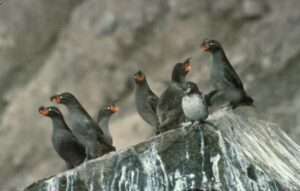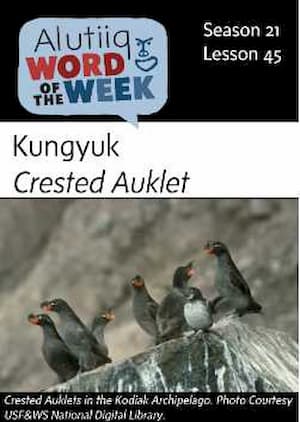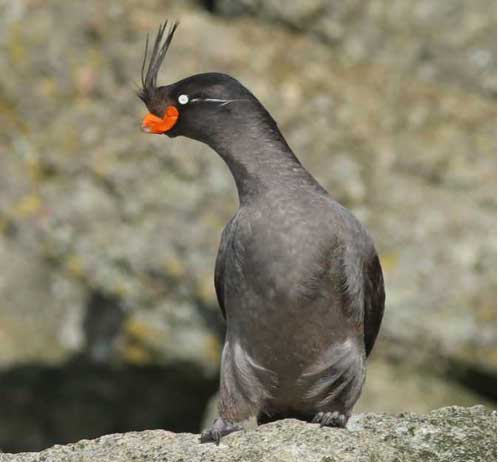
Crested Auklet — Kungyuk
Kungyut amlertaallriit kangiyami. – There used to always be a lot of crested auklets in the bay.
The crested auklet (Aethia cristatella), known by some as the sea quail, is a member of the alcid family, a group that includes auks, puffins, and murres. About two million of these sea birds live in Alaska, in the Bering Sea and the Aleutian Islands, but they range as far as the Kurile Island of Japan and the central Gulf of Alaska.
Roughly 9 inches tall, with a black back and a grey belly, these birds take their name from a distinctive tuft of black feathers found on their foreheads. This ornamental plumage curves forward over the auklet’s short orange beak. Crested auklets feed on zooplankton and nest on rocky slopes and beaches. They aggregate in colonies with other species of auklets and are known for their spectacular flocking behavior. Large groups of birds will swoop, soar, and dive together, especially during the mating season.
Kodiak lies at the far eastern edge of the crested auklet’s range. Birds can be seen in small numbers around the archipelago in the summer. However, they are more common in the cold season, when they gather in protected marine waters. Hunters recall taking auklets in the winter. Men pursued the birds on the water, often with the assistance of moonlight or by the light of the rising sun. Due to their small size, people harvested a number of birds, which they roasted or made into soup.
Alutiiq Elders report that crested auklets were once more common around Kodiak, and have declined in number. This may be why they are no longer hunted, as they seldom occur in large flocks. Although auklets are not considered endangered, Elder’s observations illustrate how people who harvest from an environment for many years can notice subtle changes in plant and animal life. Their ecological knowledge can provide information on the impacts of development, disasters, or technological changes, or chart the gradual progress of phenomena like climate change.
Listen to podcast at Alutiiq Museum website
[content id=”79272″]






